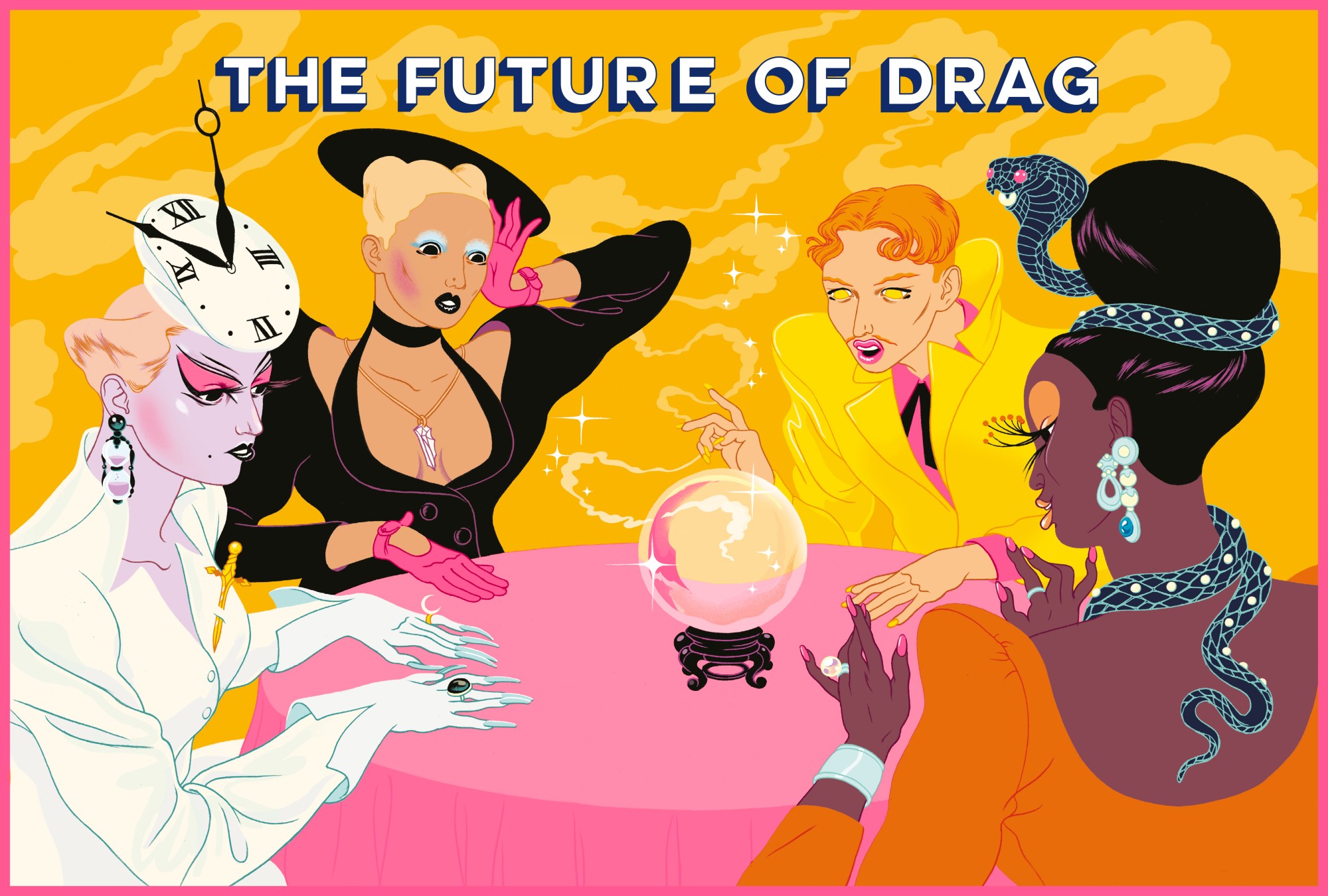You don’t need telling that drag has experienced a renaissance over the past decade. Largely due to the mainstream success of RuPaul’s Drag Race, it’s gone from an art form mostly celebrated within a queer niche to a global entertainment industry in its own right. Behind the popularity it currently enjoys, though, lies a rich, human history that stretches back centuries. Existing at the intersection of fashion, politics, theatre, sexuality and so much more, the value of drag and its development is as sociohistorical as it is rooted in aesthetics or comedy.
In The Art of Drag, a new book by writer Jake Hall and illustrators Jasjyot Singh Hans, Helen Li and Sofie Birkin, this history is explored at length — from the influences of mime and Kabuki through vaudeville, Stonewall and the Club Kids to the present day and beyond.
As much as it venerates the medium’s past, it also points out some of the key issues at its heart today. “I’ve spent more than a decade immersed in queer nightlife, so when I moved to London a few years ago, I naturally ended up writing about drag,” Jake says. “I kept seeing my friends deal with misogyny in clubs, and I kept hearing this myth that drag belonged exclusively to cis men. I knew this wasn’t the case from seeing incredible trans, non-binary and cis women performers out and about, but when I started studying queer theory, this idea of drag as a radical practice started to make more sense.”
For Jake, drag’s mainstream ascent has also proven to be a double-edged sword, leading “to a dilution of the political roots which make it such an important art form for queer people.” As such, the book’s aim from the outset was to assume an active political stance. “We know from the whitewashing of curriculums that no history is objective, no matter how much it claims to be,” they say. “The past is rewritten by those with power, and then their words are uncritically framed as factual and unbiased. This book owns that it takes an inclusive stance, and I’m so honoured that we’ve had so many incredibly talented people dedicate their time to making it as comprehensive, diverse and representative as possible.”
The broad-minded perspective it adopts when looking to the past translates into how it looks to the future, too. In its concluding chapter, published exclusively here on i-D, pioneering drag forces of our time, like The Vixen and Crystal Rasmussen, are invited to share their thoughts on what lies in store for the medium’s future. “It’s really exciting to me that the future of drag looks so expansive. This explosion in visibility means there’s really something for everyone,” Jake says. “To me personally, the future lies in artists that push it further: that blur the lines of gender entirely, or become these creepy, post-human monsters. There are amazing artists really aiming to fuck with our minds; they’re the ones that really thrill me.”

In today’s world, drag artists have an arsenal of new tools at their disposal: from trippy filters and virtual make-up to advanced prosthetics, today’s superstars use technology to create surreal imagery that distorts the idea of what it even means to look human. Thankfully, conversations around gender are becoming more progressive, too. The world is beginning to understand that anyone can do drag, and increasingly we’re talking less about kings and queens and more about drag creatures.
The artists on the following pages are just a handful of the shining stars pushing drag into the future. Crystal Rasmussen pairs her razor-sharp wit with a fabulous, glitter-strewn beard; The Vixen teams a comic-book aesthetic with a willingness to bluntly call out racism in drag, and a desire to uplift fellow Black queens with her trailblazing Black Girl Magic; Sweatmother trawls the streets of London to capture the brilliance of their community on film; while Birmingham’s Don One is injecting humour and heart into the UK’s drag king scene.
Each represents a new breed of drag: one that is unashamedly political. The rise of shows like RuPaul’s Drag Race may have opened up a certain blueprint of drag to global audiences, but underground artists are constantly working to show that drag has no gender and fits into no norm. This ethos of inclusivity is what underpins the future of this trailblazing art form. Needless to say, that future is dazzling.
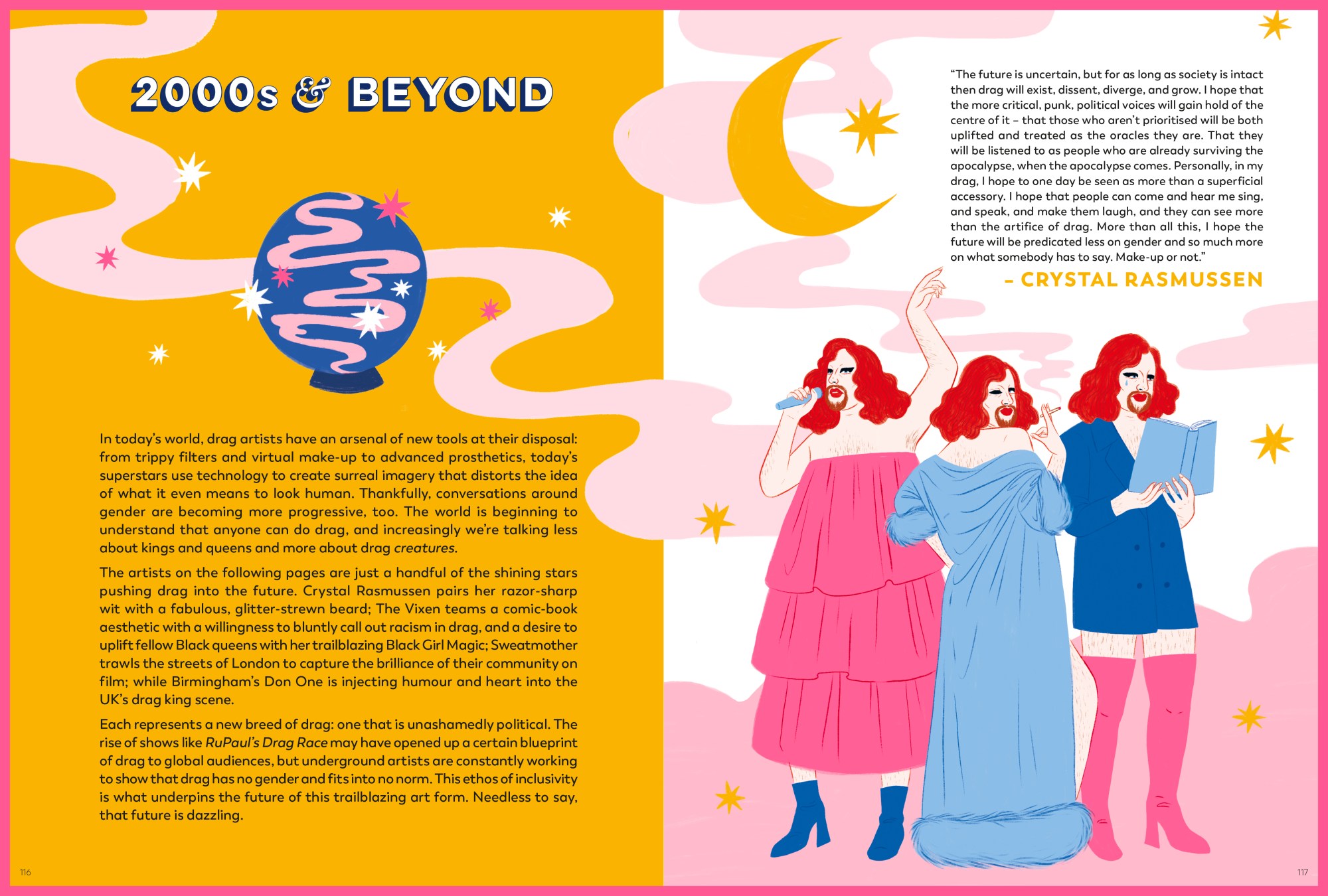
“The future is uncertain, but for as long as society is intact then drag will exist, dissent, diverge, and grow. I hope that the more critical, punk, political voices will gain hold of the centre of it – that those who aren’t prioritised will be both uplifted and treated as the oracles they are. That they will be listened to as people who are already surviving the apocalypse, when the apocalypse comes. Personally, in my drag, I hope to one day be seen as more than a superficial accessory. I hope that people can come and hear me sing, and speak, and make them laugh, and they can see more than the artifice of drag. More than all this, I hope the future will be predicated less on gender and so much more on what somebody has to say. Make-up or not.” – Crystal Rasmussen
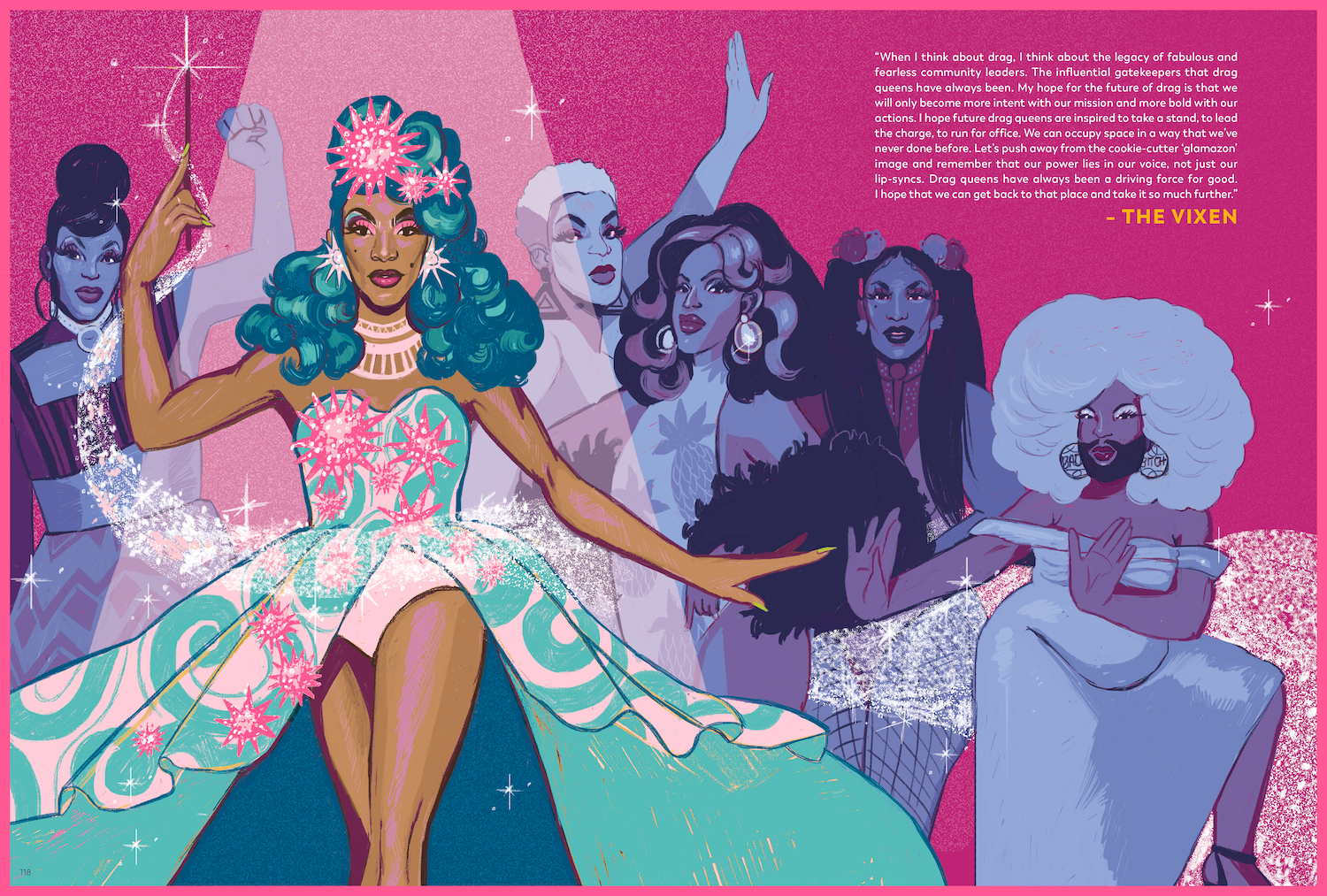
“When I think about drag, I think about the legacy of fabulous and fearless community leaders. The influential gatekeepers that drag queens have always been. My hope for the future of drag is that we will only become more intent with our mission and more bold with our actions. I hope future drag queens are inspired to take a stand, to lead the charge, to run for office. We can occupy space in a way that we’ve never done before. Let’s push away from the cookie-cutter ‘glamazon’ image and remember that our power lies in our voice, not just our lip-syncs. Drag queens have always been a driving force for good. I hope that we can get back to that place and take it so much further.” – The Vixen
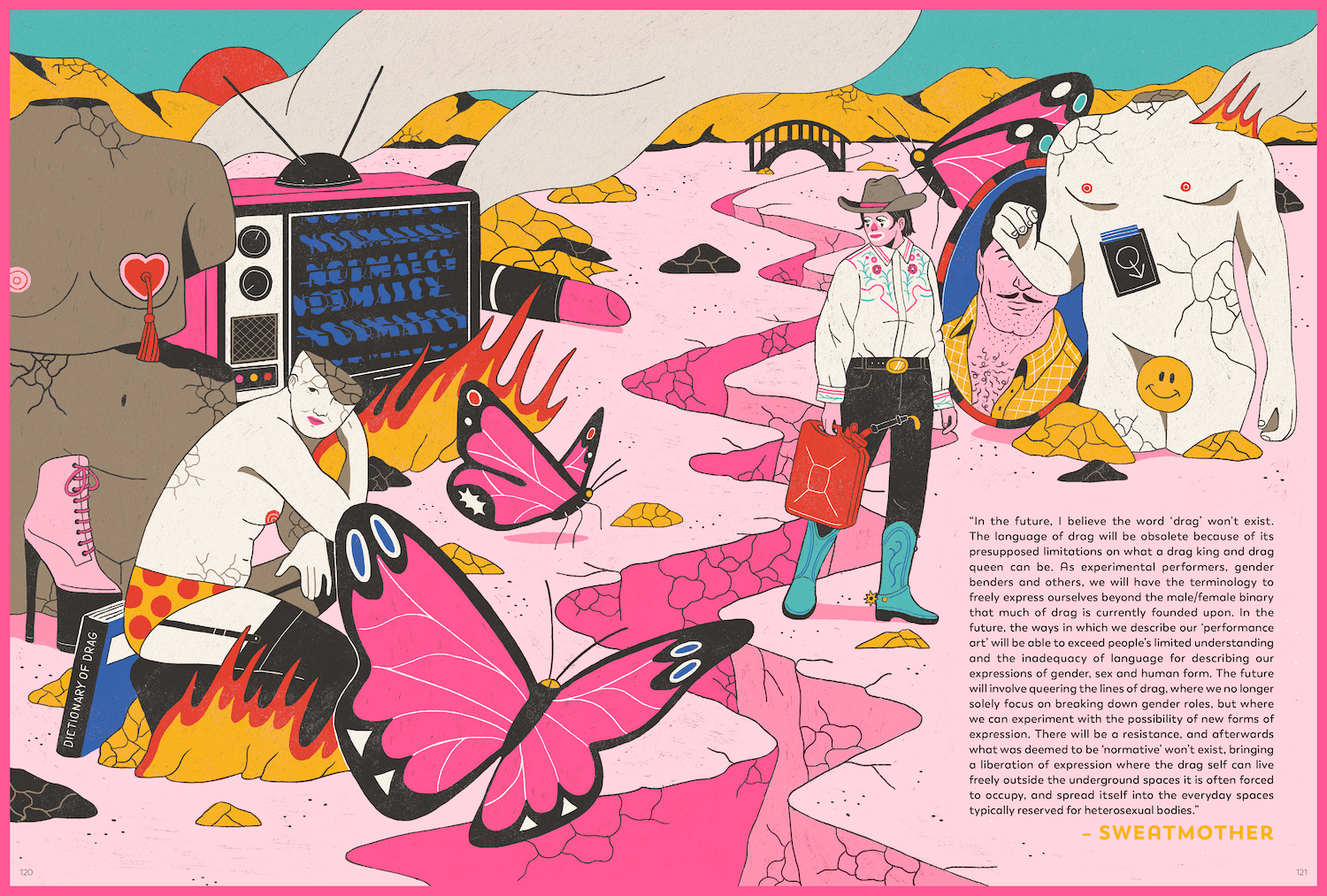
“In the future, I believe the word ‘drag’ won’t exist. The language of drag will be obsolete because of its presupposed limitations on what a drag king and drag queen can be. As experimental performers, gender benders and others, we will have the terminology to freely express ourselves beyond the male/female binary that much of drag is currently founded upon. In the future, the ways in which we describe our ‘performance art’ will be able to exceed people’s limited understanding and the inadequacy of language for describing our expressions of gender, sex and human form. The future will involve queering the lines of drag, where we no longer solely focus on breaking down gender roles, but where we can experiment with the possibility of new forms of expression. There will be a resistance, and afterwards what was deemed to be ‘normative’ won’t exist, bringing a liberation of expression where the drag self can live freely outside the underground spaces it is often forced to occupy, and spread itself into the everyday spaces typically reserved for heterosexual bodies.” —Sweatmother
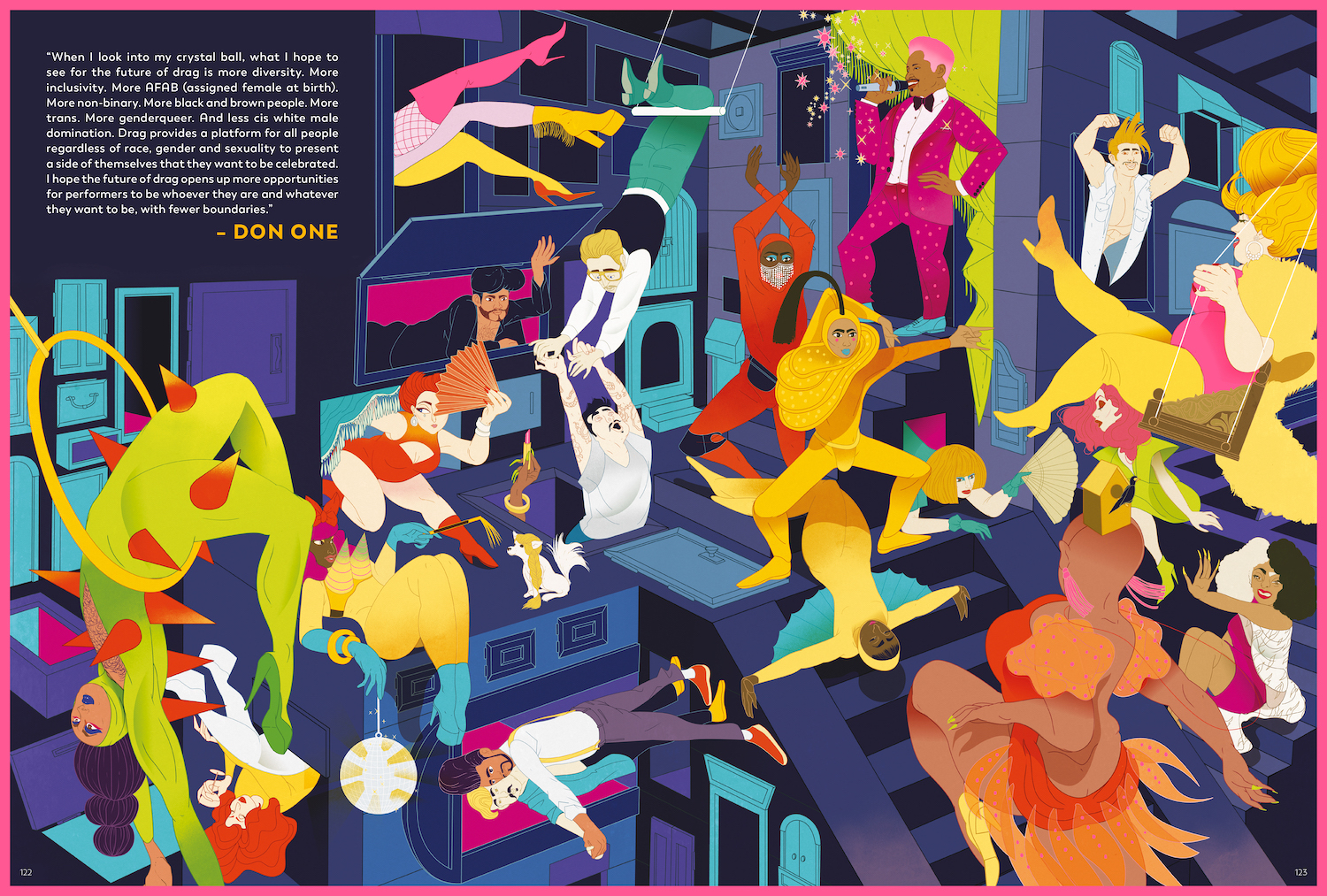
“When I look into my crystal ball, what I hope to see for the future of drag is more diversity. More inclusivity. More AFAB (assigned female at birth). More non-binary. More black and brown people. More trans. More genderqueer. And less cis white male domination. Drag provides a platform for all people regardless of race, gender and sexuality to present a side of themselves that they want to be celebrated. I hope the future of drag opens up more opportunities for performers to be whoever they are and whatever they want to be, with fewer boundaries.” – Don One
